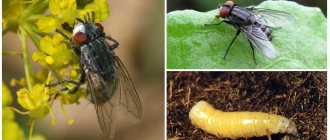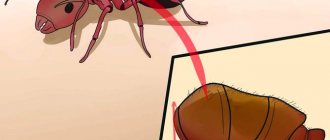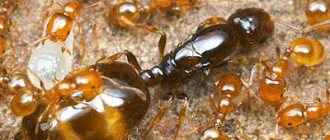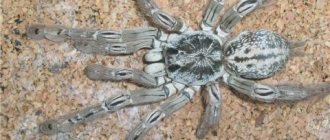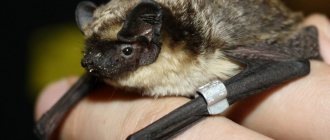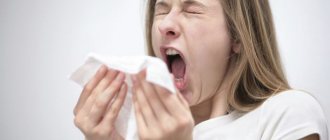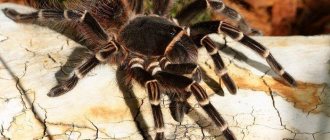10/04/2019Aquarium0
Daphnia is a crustacean organism. It is widely used as phytoplankton and food for aquarium inhabitants. It is quite difficult to create conditions for its breeding. Therefore, many aquarists use the services of pet stores, purchasing live, frozen or dried crustaceans in the required quantity.
- 1 Description, structure, lifestyle and natural habitat
- 2 Mr. Tail recommends: Daphnia as fish food
- 3 Value and benefits
- 4 Species of Daphnia
- 5 Daphnia in the aquarium
- 6 Nutrition of Daphnia
- 7 Catching Daphnia
- 8 Natural reproduction and breeding of Daphnia
- 9 Danger to humans
Description, structure, lifestyle and natural habitat
Daphnia belongs to the genus of planktonic crustaceans and is a cladoceran organism. The second name, Water Flea, was given due to its structure reminiscent of these insects and the ability to make sharp leaps in the water column. If you look under a microscope, you can make the following description of the appearance:
- a rounded body 2-6 mm long is enclosed in a bivalve shell made of transparent chitin;
- there are branched antennae on the head that help jumps in the water;
- There is only one compound eye in mature individuals, but there is an additional ocellus near it;
- in the front of the head there is a beak-shaped growth called a rostum, and under it there are antennae with olfactory bristles;
- 4-6 pairs of thoracic legs are covered with many setae and contain gill sacs intended for breathing and absorption of food;
- in the posterior part of the body there is a tail equipped with paired claws and an anus to cleanse the body of large foreign particles;
- Eggs form in a sac-like outgrowth on the back.
Photo gallery of Daphnia:
The size and color of Daphnia depend on its subtype and habitat. Thus, in spacious, clean reservoirs with a sufficient amount of oxygen and nutrients, light gray or greenish individuals live, and in small and polluted ponds they acquire a red-brown pigment.
The internal structure has the following characteristics:
- the brain and the nerve chain in the peritoneum are responsible for the nervous system;
- striated muscles help move the antennae, tail and thoracic legs;
- the digestive system consists of the mouth, small and middle intestines, 2 hepatic outgrowths and the hindgut with the anus;
- closer to the back is the heart, from which 2 ostia filled with blood arise;
- the respiratory organ is not expressed, oxygen enters the body through the membrane and from the growths of the legs;
- on both sides of the intestine there is a pair of ovaries in females or testes in males.
Daphnia live in freshwater bodies of standing water. They are distributed everywhere, including the lakes of Antarctica. For successful reproduction, they only need a clean environment with a minimum amount of silt and dirt at the bottom. Otherwise, there is a risk of accumulation of clogging substances in the intestines of crayfish, which leads to their death.
In the water column they exist as plankton, freely drifting with the current. They hide at the bottom when the sun shines too brightly, and the rest of the time they swim at the top. Life expectancy in a favorable environment is 22 days, and in a large individual it reaches 110-150 days.
Some more photographs and observations
Here are a few more successful photographs of Daphnia pulex.
In the next frame, the already hatched nauplii and the white beard of ciliates covering the surface of the crustacean are clearly visible.
Daphnia in reflected light, covered with colonies of ciliates
And yet, daphnia looks amazing from the front. It's someone else's! Or an alien ship, definitely:
Daphnia in full view - alien ship
Daphnia pulex in a drop of water
Mr. Tail recommends: Daphnia as fish food
Many aquarists and entrepreneurs prefer to grow Water Fleas as food crops for feeding small and young fish. You can also buy crustaceans in any form from them:
- live for home breeding;
- ice cream packaged in blisters;
- dry as ready-to-eat food.
This food has a number of positive aspects and has a positive effect on aquarium flora and fauna.
Aeration equipment
In order to grow river crustaceans, the tank is equipped with aeration equipment. Aeration is required if Daphnia moina is grown at home.
With the help of such devices, the aquarium liquid is saturated with oxygen, which has a positive effect on the development of phytoplankton. Oxygen prevents film development.
Aeration equipment is selected for the aquarium, which has average performance. After all, an excessive number of bubbles provokes the rise of daphnia to the surface of the water.
Value and Benefits
Daphnia is grown along with Bloodworm, Gammarus, Caddisfly, Amphipod, Cyclops, Prudovik and other food organisms. In terms of calorie content, they are all approximately equal, but the first has a higher protein content. Amino acids absorbed by young fish have a beneficial effect on their growth and development. Because of this, Daphnia is used commercially and added to many dry foods. In this form, 50% of their mass consists of proteins.
Live food is of particular importance in the diet of fish. It minimizes their incidence, is easier to digest during illness and facilitates adaptation to new conditions.
Crustaceans usually have a stomach filled with plant particles, so they are preferred as food by Guppies, Danios, Fire Barbs, Crucians, Carps and other aquatic inhabitants. In an aquarium, such nutrition is especially useful for fish deprived of a natural diet. The chitin shell, which is not digested, activates the intestines and starts its cleansing.
Moreover, they are unpretentious in care and multiply quite quickly. They benefit the entire aquarium by filtering the water in it. One individual eats 6 times more food per day than it weighs. This helps get rid of foreign microorganisms in a pond or tank.
How to fish in reservoirs yourself
It is customary to catch daphnia from the spring season until the end of autumn, until an ice crust forms on the reservoirs.
It is better to catch small crustaceans with a regular canvas net. They are then passed through sieves, sorting the individuals by size.
It is necessary to go fishing in as calm and cloudy weather as possible. Typically this should be in the morning or evening. In such conditions, crustaceans rise closer to the surface of the water.
During the catching process, daphnia are periodically shaken out into a special tin vessel. The crustaceans are then transported in the same cans. Do not forget that at very high densities, individuals may die during transportation.
Important! Before using daphnia as fish food, all specimens must be decanted and washed in settled water. It is unacceptable to bring unwashed “live food” into a vessel with fish, or, worse, pour it along with water from a natural reservoir. You risk introducing infection and parasites into the water.
Species of Daphnia
Their genus includes more than one hundred species of cladocerans, which belong to approximately 10 families. In Russia you can find three varieties:
- Magna is considered the largest, reaching a length of 6 mm in the female, 2 mm in the male and 0.7 in the larva. It matures in 12-14 days and gives birth in 2 weeks, laying an average of 20-30 and up to 80 eggs (ephippia) at a time. Lives approximately 110-150 days.
- Pulex is medium in size, the female grows up to 3-4 mm, and the male no more than 1-2 mm. It reproduces every 3-5 days, producing 10-25 eggs. The life cycle is 26-47 days.
- Moina is the smallest, has a soft shell and is suitable for feeding fry. It grows no more than 1.5 mm, and newborns are 0.5 mm. Maturation occurs within a day, and litters appear every 1-2 days, up to 53 ephippia each. Lives for approximately 22 days.
These three types can be bred even by amateurs, without requiring special maintenance. But the specifics of caring for them and interacting with other inhabitants are still worth knowing.
Daphnia in the aquarium
To breed crustaceans in closed tanks, you must provide certain conditions for their existence:
- choose a clean container made of glass or plexiglass, initially with a capacity of 1-3 liters, replacing it as the number of inhabitants increases, taking into account a density of 0.3-1 kg/m³;
- use purified water or from the tap, with a hardness of 6-18° and a neutral pH of 7.2-8, without chlorine and chemical impurities, for which it can be filtered;
- place it away from direct sunlight, as crustaceans do not like excessive light;
- install a 20 W fluorescent lamp, providing light lighting for 14-16 hours every day;
- provide temperatures within +20…+24 °C for Daphnia vulgaris and +26…+28 °C for Moin; in a cool habitat the reproduction rate will decrease;
- provide complete nutrition by dissolving the fertilizer in the liquid until it becomes slightly cloudy, and adding a new portion after clearing;
- as necessary, clean and change the water so that debris and silt do not accumulate at the bottom, as well as plaque on the walls;
- use weak aeration to remove film on the surface, mix food, provide oxygen access of at least 3-8 mg/l and oxidation 14.8-26.2 mg O2/l.
First, you should purchase crustacean eggs and place them in a prepared container. Already matured individuals need to be caught with a net in order to immediately be fed, dried or frozen.
How to catch?
In the natural habitat for daphnia, it is not difficult to catch them. To do this, you need to purchase a special net - the handle must be at least 2 m long, about 28 cm in diameter and a 50 cm fabric cone with a rounded end. It is best if the net ring is made of stainless wire with a diameter of 5 mm; the thinner one will bend on the bottom of the reservoir.
Daphnia in the aquarium
The net should be made of synthetic fabric that does not rot from frequent contact with water. The size of the mesh cells should correspond to the size of the crustaceans that need to be caught; moreover, if the fabric is too small, the net will slow down in the water, so it is better to prepare several nets at once.
You should catch daphnia by moving the net slowly and smoothly in places where they accumulate; after making a few movements, you need to shake out the catch and catch further, since if you collect a net full of crustaceans at once, they will crumple and die.
It is better to catch daphnia from shallow reservoirs, since such individuals are more accustomed to oxygen starvation and can more easily tolerate transportation. It is best to do this early in the morning or before sunset, since the brighter the sun, the deeper the crustaceans migrate to the bottom.
Caught daphnia should be placed in a special container, such as a can, after first straining the crustaceans to remove debris and larvae of other inhabitants of reservoirs. The temperature of the water in the container should not differ from the temperature in the reservoir; if the difference is too great, the crustaceans may die.
Having delivered the catch home, you should pour it into a wide basin and wait a little so that the dead crustaceans appear at the bottom.
It is better not to catch daphnia in the spring and early summer, since during this period their diet contains plant pollen, which is carried by the wind; if you catch crustaceans during this period, a person may get an allergic reaction during feeding.
Nutrition of Daphnia
In nature, Water Fleas feed on simple microorganisms:
- blue-green algae from unicellular organisms;
- ciliates;
- fungal spores;
- bacteria;
- detritus (remains of invertebrate animals).
A suitable environment is created in ponds with a small number of fish and a large number of phytoplankton, which creates the effect of a bloom in the water column. In artificial tanks, crustaceans should be fed with the following products:
- The bacteria are obtained from banana peels, food waste or excrement. To do this, they should be soaked in water for up to a week until it begins to become cloudy. Add the resulting liquid to the tank, 450 ml per 20 liters, every 5-6 days.
- Microscopic algae and other plankton will remove excess contaminants and serve as food for Water Fleas. To obtain them, you should scoop up the liquid from the stocked aquarium and place it in a sunny, warm place at +18...+25 °C.
- Yeast can be dried or raw, frozen to a rich color. Dilute in water at +35 °C at the rate of 1-3 g per 1 liter. They should be used 2-3 times a week, in combination, as they have less nutritional value.
- Beetroot, cabbage or carrot juice will serve as a vitamin supplement. You need to add 1 tsp to the container. for 5 liters of volume.
- Dry the elodea, nettle or lettuce, chop it, grind it in gauze, and add it to a container of water. When it turns green, introduce crustaceans there. Repeat every 10-15 days.
- A couple of times a week you can add ammonium nitrate at 1 g/100 l, phosphorus salts up to 5 mg/l, or other mineral fertilizers.
- Stale blood or water remaining from washing fresh meat (1.5-2 cm3/l), blood or meat and bone meal (0.5-2.5 cm3 per 10 l), manure (1.5 kg/m3).
During the feeding process, crustaceans create a current by raking with their chest paws. It is on them that the organs that send microelements to the esophagus are located. Inside there are organs that produce a sticky substance that collects individual food particles into clumps. Inside the esophagus, they go through all stages of digestion and only large excesses come out.
How to dilute at home
When starting to grow freshwater organisms, you should first prepare a suitable container. In addition, you must know how to create all the necessary conditions for these individuals. It is how to properly breed daphnia at home that will be discussed later in the article.
Growing vessel or aquarium
A container with a volume of 15-20 liters is ideal for growing “live food”. When selecting a vessel, take into account the following instructions:
- choose a material that does not release hazardous chemicals into the water (for example, synthetic polymers). The ideal container is a glass vessel or an aquarium;
- if you are using a simple glass vessel, the area in contact with air should be extremely large. This condition is required for natural gas exchange and the supply of oxygen to small crustaceans;
- if you still choose a metal container, it should not be made of stainless steel;
- If you plan to keep a vessel with crustaceans indoors with bright lights or outdoors under bright sunshine, take a container with a minimum volume of 40 liters.
In aquariums you can breed fish such as: guppies, surgeon fish, arowana, discus, gourami, platies, astronotuses, cockerel fish, veiltails, clown fish, lalius, ancistrus, platies, catfish, barbs and parrots.
Physical conditions
Next, we will consider the physical conditions required for successful breeding of daphnia.
- Temperature . Crustaceans adapt to a wide range of temperatures. The ideal temperature is +18-22 °C. Daphnia pulex perfectly withstands fluctuations above 10 °C. For the Magna crustacean in nature, the optimal temperature is reached only once a year.
- Salinity . Daphnia is a freshwater living organism. The genus of planktonic crustaceans to which it belongs does not include marine representatives. 99% of crustaceans are freshwater, while the rest live primarily in brackish and seawater. Some specimens were found in water with a salinity of over 0.004 ppm.
- pH and ammonia . The optimal pH value is 6.5-9.5. Ammonia, even in low concentrations, is toxic to all living organisms. However, in an alkaline environment, the level of ammonia toxicity increases sharply, which does not affect the health of daphnia, but negatively affects the reproduction of individuals. So, low levels of pH and ammonia do not pose a threat to the successful breeding of daphnia. A significant increase in the pH value increases the toxicity of dissolved gases and minerals.
- Oxygen . Crustaceans do well in dirty water. In this case, the indicator of dissolved oxygen can fluctuate from practically zero to supersaturated levels. This endurance of the culture is due to the ability to form hemoglobin. Crustaceans cannot withstand intense air exchange with small air bubbles. These bubbles can kill small individuals. However, very slow aeration can also kill small crustaceans. Slow air exchange forms a foaming layer on the surface of the water that is harmful to these living organisms.
- Dissolved minerals . Crustaceans are very vulnerable to changes in the chemical component of their environment. They die when magnesium, potassium, zinc, sodium and calcium are added. Low phosphorus content activates the reproduction process, but saturation exceeding 0.001 ppm is fatal to young animals. Even the lowest copper content causes a decline in the mobility of these organisms. Small organisms are also very susceptible to dissolved toxins (pesticides, bleaches, detergents). In turn, nitrogen, which stimulates algae growth, does not affect daphnia. Aeration or dechlorination must be used to remove chlorine from the aquarium. You can also add a small dose of tuff stone (in powder form). City or natural water is usually too polluted. Distilled water cannot be used either, as it does not contain the required minerals. For daphnia, it is better to take water that is drawn from an aquarium with fish. It is also possible to use filtered lake water or rainwater.
A home for aquarium fish and other aquatic inhabitants needs high-quality clean water, because otherwise your swimming pets will not be very happy and, most likely, will not live with you. Read how to choose a filter, plants and background for your aquarium, and how to use Methylene Blue aquarium conditioner.
Catching Daphnia
Water fleas can be collected independently from small lakes, ponds with waterfowl, pits, ditches and other bodies of water with minimal aquatic life. They do not breed in river conditions, but only in standing water. They are quite easy to detect by coloring the thickness in a gray-green or brownish tint.
You should not look for them in heavily dammed reservoirs or lakes with many fish and predators. The presence of the latter will affect not only the quantity of plankton, but also its quality, and will also increase the risk of the spread of diseases to aquarium fish.
To catch bioplankton, you need to take a fine-mesh net or muslin sieve. The scooping motion should follow a figure eight shape and be slow. Rapid scooping leads to increased pressure on the crustaceans and to their death.
The best time for this is during the period of water bloom, when the concentration of algae in it increases. Moreover, it is easier to do this in a shaded area of shallow water, in the evening or on a cloudy day. After all, the attitude of crustaceans to bright sunlight is negative; under them, plankton-like creatures tend to go deeper closer to the bottom.
Natural reproduction and breeding of Daphnia
Water fleas are not asexual creatures, as evidenced by the presence of ovaries in females and testes in males. They also differ in the size and structure of the antennae. But in them, like all cladocerans, reproduction occurs through cyclic parthenogenesis. Same-sex reproduction is especially important when only female individuals remain in the population. Moreover, in warm summer weather, young females develop from their unfertilized eggs. In autumn and when water bodies dry up, males emerge from such ephippia. Their embryos are born under the shell and wait several molts before emerging.
When fertilization is complete, smaller and faster males mate with females, attaching themselves to the rear edge of the shell. During parthenogenesis, all litters are the same sex. After colder weather and decreased daylight hours, bisexual reproduction occurs. In this case, some individuals give birth to males, while others lay ephippia, which are dormant until fertilization. They spread with the wind, on the legs or feathers of birds, the fur of mammals, and in the intestines of fish. In winter, they are found on the water surface or in the upper layers of silt. They are resistant to frost or drying out, and when placed in a favorable environment, embryo development begins.
For cultivation, dry eggs are taken and placed in a suitable environment. They grow and multiply quickly, which makes it possible to obtain 30-50 g of crustaceans from 1 m3 of ephippia. Feeding has two directions:
- Joint, in which food is brought into the tank with Daphnia. The negative is rapid contamination and the need for frequent fluid replacement.
- Separate is convenient for mass breeding. At the same time, algae is grown in a separate container, which is introduced into the tank 1-2 times a day during feeding.
Industrial cultivation of forage crustaceans in large pools and dams is now popular. In this case, the producer changes the water and replants the crop every few weeks or months to prevent it from aging.
Reproduction of individuals
Daphnia are distinguished by the peculiarity of breeding offspring without fertilization. Females of this species have a brood chamber. It is protected by the edge of the shell and is located on the back. Under favorable conditions, an adult can lay 50 to 100 unfertilized eggs. They develop in the cavity, and only females, and leave it independently. In females, molting begins after this.
After a few days, the reproduction process begins to repeat. Adult individuals join this cycle, so everything happens very quickly. One female can give birth to offspring up to 25 times over the entire period of her life. Because of this, in the summer you can observe a reddish color of water in reservoirs where daphnia live. It is simply teeming with a huge amount of plankton.
With the onset of autumn, males join the breeding process. After fertilization, the shell on the eggs becomes denser. Future offspring are able to withstand frosts, as well as drying out water bodies, and spread with dust. When spring arrives, the breeding cycle begins to repeat again as females emerge. A new population of individuals may differ in body shape at different times of the year.
https://youtube.com/watch?v=rcNedJCHAh8
Danger to humans
Because of their association with insects, many people believe that Water Fleas bite. But they do not have the corresponding organs, which means that such bites are excluded. Daphnia can cause harm only by causing an allergic reaction in people predisposed to it. As they absorb food, they also accumulate dangerous pollen, the concentration of which increases in dried organisms.
According to statistics, crustaceans cause allergies in almost every fourth person. It manifests itself in the following symptoms:
- itchy skin rashes, like hives;
- dryness and congestion of the nasal sinuses, runny nose;
- frequent involuntary sneezing;
- allergic conjunctivitis with tearing;
- difficulty breathing due to bronchospasm;
- bronchial asthma.
To diagnose the condition, doctors analyze a skin test. In case of positive results, antihistamines are prescribed and contact with Daphnia is avoided.

